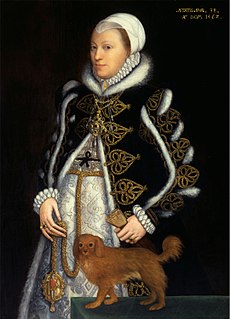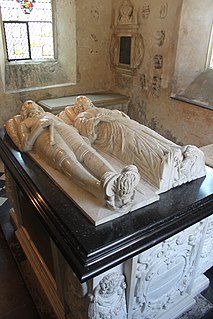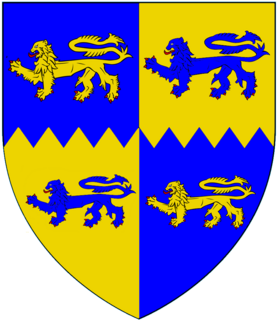Related Research Articles

Edward Montagu, 2nd Earl of Manchester, KG, KB, FRS was an important commander of Parliamentary forces in the First English Civil War, and for a time Oliver Cromwell's superior.

Catherine Carey, after her marriage Catherine Knollys and later known as both Lady Knollys and Dame Catherine Knollys,, was chief Lady of the Bedchamber to Queen Elizabeth I, who was her first cousin.

Simon Forman was an Elizabethan astrologer, occultist and herbalist active in London during the reigns of Queen Elizabeth I and James I of England. His reputation, however, was severely tarnished after his death when he was implicated in the plot to kill Sir Thomas Overbury. Astrologers continued to revere him, while writers from Ben Jonson to Nathaniel Hawthorne came to characterize him as either a fool or an evil magician in league with the Devil.
Richard Napier was a prominent English astrologer and medical practitioner.
Sir William FitzWilliam (1526–1599) was an English Lord Justice of Ireland and afterwards Lord Deputy of Ireland. In 1587, as Governor of Fotheringhay Castle, he supervised the execution of the death sentence on Mary, Queen of Scots. He was the Member of Parliament for Peterborough and represented County Carlow in the Irish House of Commons. He lived at Gainspark, Essex, and Milton Hall.
Sir William Cornwallis was an early English essayist and served as a courtier and member of Parliament. His essays, influenced by the style of Montaigne, rather than that of Francis Bacon, became a model for later English essayists. He has sometimes been confused with his uncle of the same name.

John Harington, 1st Baron Harington of Exton in Rutland, was an English courtier and politician.

Bellott v Mountjoy was a lawsuit heard at the Court of Requests in Westminster on 11 May 1612 that involved William Shakespeare in a minor role.

Henry Edward Napier was a British naval officer and historian.
Sir William Sidney (1482?–1554) was an English courtier under Henry VIII and Edward VI.

Sir Edward Hungerford (1596–1648) of Corsham, Wiltshire and of Farleigh Castle in Wiltshire, Member of Parliament, was a Parliamentarian commander during the English Civil War. He occupied and plundered Salisbury in 1643, and took Wardour and Farleigh castles.

Edward Cromwell, 3rd Baron Cromwell was an English peer. He was the son of Henry Cromwell, 2nd Baron Cromwell by his wife Mary, daughter of John Paulet, 2nd Marquess of Winchester and his first wife Elizabeth Willoughby. His grandfather, Gregory, son of Thomas Cromwell, chief minister to Henry VIII, was created Baron Cromwell on 18 December 1540.

Sir Oliver Cromwell was an English landowner, lawyer and politician who sat in the House of Commons at various times between 1589 and 1625. He was the uncle of Oliver Cromwell, the Member of Parliament, general, and Lord Protector of England.

Theodosia Harington, Lady Dudley was an English aristocrat who was abandoned by her husband, but maintained connections at court through her extensive family networks.
Sir James Harington, 1st Baronet (1542–1613/4) of Ridlington, Rutland was an English politician.
Sarah Harington (1565–1629) was an English courtier.
Mabel Harington, was a courtier to Elizabeth I of England and the sixth daughter of Sir James Harington and Lucy Harington, the daughter of Sir William Sidney of Penshurst, Kent. She married Sir Andrew Noel of Dalby and Brooke, having 7 children. Later dying in 1603.
Margaret Harington an English woman in 16th-century Spain.
Sir Edward Wingfield of Kimbolton (c.1562-1603), member of Parliament and author of a masque.
Katherine Doyley Dyer notable for the epitaph she placed on her husband's tomb at Colmworth, Bedfordshire, England
References
- ↑ John Burke & John Bernard Burke, A Genealogical and Heraldic History of the Extinct and Dormant Baronetcies (London, 1841), p. 179: Henry George Watson, A History of the Parish of Great Staughton (St Neots, 1916), p. 14.
- ↑ Roger Kuin, The Correspondence of Sir Philip Sidney, vol. 1 (Oxford, 2012), p. 1284.
- ↑ Henry George Watson, A History of the Parish of Great Staughton (St Neots, 1916), pp. 13, 15.
- ↑ Patricia Phillipy, Shaping Remembrance from Shakespeare to Milton, vol. 1 Cambridge, 2018), p. 87.
- ↑ Henry George Watson, A History of the Parish of Great Staughton (St Neots, 1916), pp. 13-14.
- ↑ Lauren Kassell, Michael Hawkins, Robert Ralley, John Young, Joanne Edge, Janet Yvonne Martin-Portugues, and Natalie Kaoukji (eds.), ‘Lady Catherine Dyer (PERSON29811)’, The casebooks of Simon Forman and Richard Napier, 1596–1634, accessed 18 August 2019.
- ↑ "My Dearest Dust", Poetry Foundation: Susan Dunn Hensley, 'Katherine D'Oyley Dyer', in Carole Levin, Anna Riehl Bertolet, Jo Eldridge Carney, A Biographical Encyclopedia of Early Modern Englishwomen (Abingdon, 2017) p. 571.
- ↑ Lauren Kassell, Michael Hawkins, Robert Ralley, John Young, Joanne Edge, Janet Yvonne Martin-Portugues, and Natalie Kaoukji (eds.), ‘Lodowick Dyer (PERSON48231)’, The casebooks of Simon Forman and Richard Napier, 1596–1634: a digital edition, accessed 18 August 2019.
- ↑ Jane Stevenson & Peter Dyer, Early Modern Women Poets (1520-1700): An Anthology (Oxford, 2001), pp. 222-4: Catherine, the poet, was a Doyley of Merton co-heir, and the sister of Margaret Doyley, the wife of Edward Harington of Ridlington.
- ↑ E. H. Martin, Family', Notes & Queries for Somerset and Dorset, vol. 10, (Sherborne, 1907) no. 99 pp. 145-157 at p. 147, 148-9.
- ↑ Lauren Kassell, Michael Hawkins, Robert Ralley, John Young, Joanne Edge, Janet Yvonne Martin-Portugues, and Natalie Kaoukji (eds.), ‘Mr Richard Dyer (PERSON48232)’, The casebooks of Simon Forman and Richard Napier, 1596–1634: a digital edition, accessed 18 August 2019.
- ↑ Lauren Kassell, Michael Hawkins, Robert Ralley, John Young, Joanne Edge, Janet Yvonne Martin-Portugues, and Natalie Kaoukji (eds.), ‘Mr Edward Dyer (PERSON48230)’, The casebooks of Simon Forman and Richard Napier, 1596–1634: a digital edition, accessed 18 August 2019.
- ↑ "Lady Carr Cromwell", Lady Dyer, young Lady Dyer, and other women of the Harington/Sidney family were mentioned in the 'Will of William Mason, Gentleman of Westminster, Middlesex', 2 February 1630, TNA PROB 11/157/110.
- ↑ Oliver Cromwell, Memoirs of the Protector Oliver Cromwell and of His Sons Richard and Henry (London, 1820) pp. 203-4.
- ↑ M. W. Helms & E. R. Edwards, 'CROMWELL (afterwards WILLIAMS), Henry (1625-73), of Bodsey House, Ramsey, Hunts', The History of Parliament: the House of Commons 1660-1690, ed. B.D. Henning, (1983).
- ↑ Samuel Gardiner Rawson, Fortescue Papers (London, 1871), pp. 63-5, 70-1.